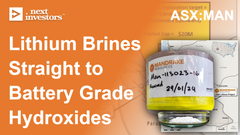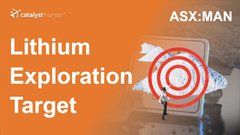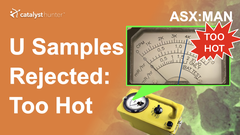MAN Delivers Lithium Discovery in USA Brines. MAN Uranium Fieldwork Commencing.
Disclosure: S3 Consortium Pty Ltd (the Company) and Associated Entities own 2,860,000 MAN shares at the time of publishing this article. The Company has been engaged by MAN to share our commentary on the progress of our Investment in MAN over time.
Yesterday, our US clean energy materials Investment, Mandrake Resources (ASX:MAN) announced a lithium brine discovery in Utah.
... and in parallel, MAN will shortly be mapping and sampling for uranium (the “commodity of the moment”) across its project area too... .
It just so happens that MAN’s project area, while being highly prospective for lithium, also happens to be in the most significant uranium mining district of Utah.
MAN announced plans to scout their large land package for uranium in this Utah lithium district in October last year, months before the uranium spot price run became a mainstream narrative.
MAN held $15.5M in cash and was capped at $24M, so has enough runway to progress both its lithium and uranium exploration over the coming months.
We will be watching MAN’s moves on uranium over the coming months...
... but for now, MAN is aiming to define a large lithium exploration target across its project area.
In early 2023, $587BN capped energy supermajor ExxonMobil paid at least US$100M for an early stage lithium project in the US that has the potential to deliver battery grade lithium by re-entering old oil and gas wells and extracting the brine containing lithium.
Exxon’s move brought the race to unlock US Direct Lithium Extraction (DLE) tech into the mainstream narrative.
DLE is a technology that extracts lithium from brine water pumped from deep underground. The lithium is separated from the brine, and the brine is pumped back underground, closing the loop.
DLE technology promises to produce lithium for less money, can respond quicker to demand changes, and has a lower ESG footprint than hard rock lithium mining.
There are hundreds of millions of dollars being spent around the world on trying to find the best solution at scale - including by Exxon Mobil.
We are planning to head over to the US next month to learn more about brine, oil field extraction of lithium, and the US DLE industry as whole - and will provide our notes when we get back.
And further down you can listen to Mr Lithium Joe Lowry’s view on DLE technology, in a podcast with Exxon Mobil’s Lithium Global Business Manager.
Hint: they are bullish on DLE technology and the USA - so MAN is in the right place.
But before ExxonMobil’s move into lithium hit the headlines in a big way, MAN was already positioned with a large land package in Utah’s Paradox Basin.
MAN’s project is located in a historic mining (copper/uranium) and oil and gas province in a pro-mining state (Utah) with quality infrastructure and a supportive local administration.
MAN acquired the land back in February of last year and the plan was to re-enter old oil wells on the hunt for lithium in brines.
Last year MAN also announced the intention to search for uranium, bromine and potash - more on this later.
Even though MAN has a decent amount of cash for its size ( ~$15M in the bank), MAN’s goal was to start off with a quick and low-cost test called “wireline bailer” sampling for lithium...
These are conservative tests as they can return relatively diluted lithium concentrations when compared to brines collected through swabbing.
Given yesterday’s results came back positive, we think this sets up MAN nicely to deliver even better concentrations in subsequent exploration efforts.
Yesterday MAN released initial sampling results from a wireline logging program.
MAN returned a peak lithium concentration of 147mg/L and a second result of 140mg/L.
These results were better than MAN expected for this type of conservative first stage test, and it has set up the company nicely for releasing a lithium exploration target across the project.
Beyond this week’s news, here’s what we’re looking for next from MAN in the coming two quarters:
- Permitting for a re-entry/drill program in Q1 2024 🔄
- JORC Lithium Exploration Target in Q1 2024 🔄
- DLE testing results 🔄
- Uranium fieldwork and sampling 🔄 - MAN has an extensive land package in an old uranium producing district - MAN signalled its intention to test for U back in October 2023.
- An update on bromine and potassium - This week’s results included bromine and potassium results that could be very valuable by-products of MAN’s lithium project. Bromine and potassium are important parts of multi billion $ industries and the concentrations could be broadly in line with major projects.
So this week we have had confirmation that YES there is lithium on MAN’s project in Utah:
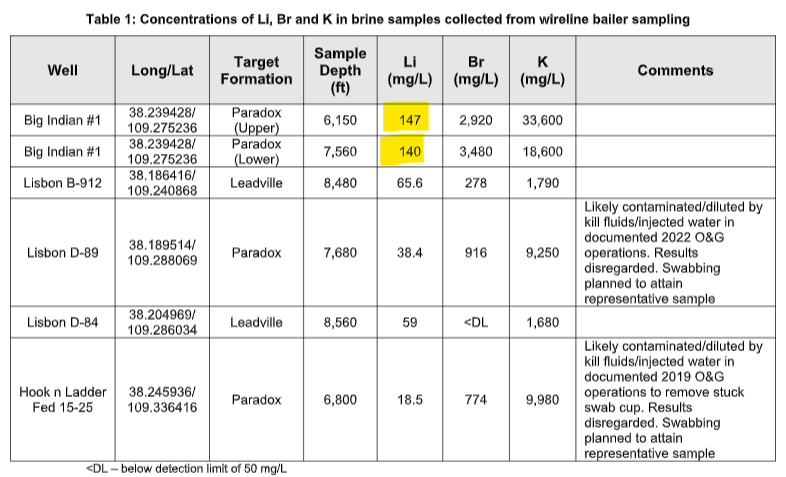
The presence of lithium is definitely a win for MAN - even with the lithium market working through a current soft patch.
(We still think lithium prices will come back eventually by the way.)
MAN is currently capped at ~$23.3M with a 30 September cash balance of ~$15.5M - so it's certainly got a good cash runway to ride out the current poor price of lithium.
And hopefully by the time lithium prices improve, we want MAN to have figured out how to extract lithium from its project via Direct Lithium Extraction (DLE).
Like all new technology, DLE has faced some scepticism in the past, but guess who is putting money behind the technology?
Enter MAN’s new Bill Gates backed DLE tech team.
MAN signed a Strategic Alliance Agreement with the DLE company late last month - and that DLE team is already working with MAN’s samples to see if they can produce lithium.
One of only a handful of DLE companies backed by Bill Gates’ Breakthrough Energy Group
More on this DLE tech provider later in this note...
For now though, it’s important to know that DLE is an emerging technology - yet to be fully proven at significant scale.
Our view is that any proof points MAN can announce on the DLE side should be very well received by the market.
We think DLE could come rushing back into vogue if the right advancements are made.
This is a view shared by Joe Lowry, likely the world’s foremost expert on the lithium market and host of the widely followed Global Lithium podcast:

Joe was interviewing one of the biggest current proponents of DLE technology, ExxonMobil’s Patrick Howarth who is Lithium Global Business Manager for the oil supermajor.
That’s right, $595BN capped ExxonMobil is now going hard at lithium, aiming to be one of the largest suppliers in the world by 2030.
To get there, ExxonMobil is targeting lithium production from brines similar to the one’s MAN just pulled up, as soon as 2027.
It’s an intriguing conversation, which at one point had Joe Lowry say around the 50 minute mark:
“To me the real promise of DLE isn’t in South America...because you can’t build a pond system in Arkansas...to me DLE is going to unlock so much resource.”
What we think Joe is saying here is that DLE will be the focus for large Western economies like the US, and their biggest companies.
For context, ExxonMobil is roughly 26 times larger than Albemarle, the biggest Western lithium company.
Just as Patrick mentioned on the podcast above - Exxon’s business moat is in drilling wells, pumping hydrocarbons to surface and turning it into saleable oil/gas products.
Exxon’s plan now is to just apply all of its existing technical knowledge to lithium brines instead of just oil and gas.
ExxonMobil is no stranger to tech advancements - they developed the first Lithium Ion battery way back in the 70s.
AND in early 2023 as we pointed out earlier, ExxonMobil put at least US$100M into a US lithium brine project.
Which is why we’re not betting against MAN and their Bill Gates backed DLE tech boffins.
In fact, ideally, MAN helps crack the code.
We are Invested in MAN to see it get to a maiden JORC resource, sign a DLE partnership and take its US lithium brine project into the feasibility stage - all of this forms the basis for our MAN “Big Bet” which is as follows:
Our MAN “Big Bet
“MAN returns 1,000%+ by making a lithium discovery significant enough to move into development studies, or attract a takeover offer.”
NOTE: our “Big Bet” is what we HOPE the ultimate success scenario looks like for this particular Investment over the long term (3+ years). There is a lot of work to be done, many risks involved, and it will require a significant amount of luck. There is no guarantee that it will ever come true. Some of these risks we list in our MAN Investment Memo.
More on MAN’s lithium discovery in Utah
With the lithium market currently suffering after prices fell more than 80% last year, we think well funded companies like MAN are well placed to ride out the hard times.
And if, or depending on who you talk to, WHEN the lithium market comes back, by that time MAN hopefully has shown signs that its DLE process works and has released a JORC resource.
Yesterday’s discovery of lithium by MAN in Utah is a great step in that direction.
This is the table of results again:
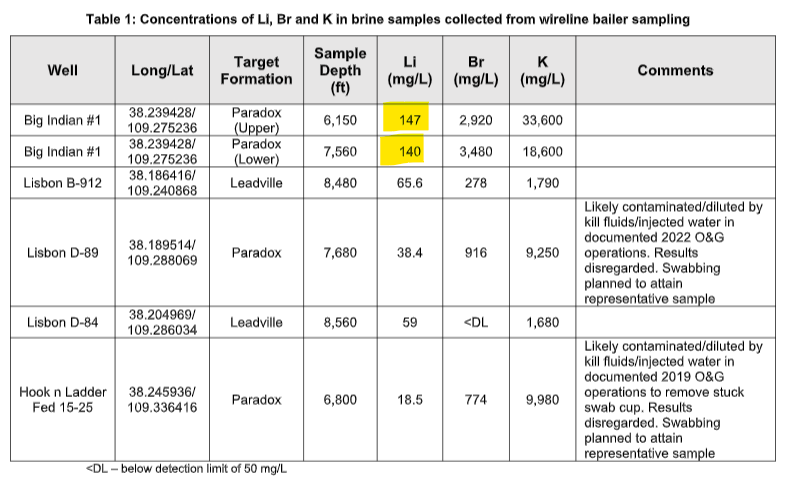
The peak concentration of 147mg/L and a second result of 140mg/L are largely comparable to what MAN’s regional peer Anson Resources has on its project.
Anson is currently capped at ~$147M and at its peak in September 2022 hit a market cap of ~$490M.
Anson is MAN’s ASX-listed neighbour in the Paradox basin, and has an average concentration of 124mg/L across a project that is currently seeking funding following a DFS in September 2022.
Like MAN, Anson is pursuing a US lithium brine project - one that uses DLE tech to pull lithium out of brines like the ones found in the Paradox Basin where MAN’s project also sits.
Back in June 2022 Anson announced an MOU with Sunresin for partnership on applying DLE to its project.
Off the back of that news Anson’s share price went from ~14c to just under 50c per share.
At the end of that run, Anson’s market cap peaked at ~$490M.
Right now Anson has a market cap of ~$147M - compared to MAN’s $23M.
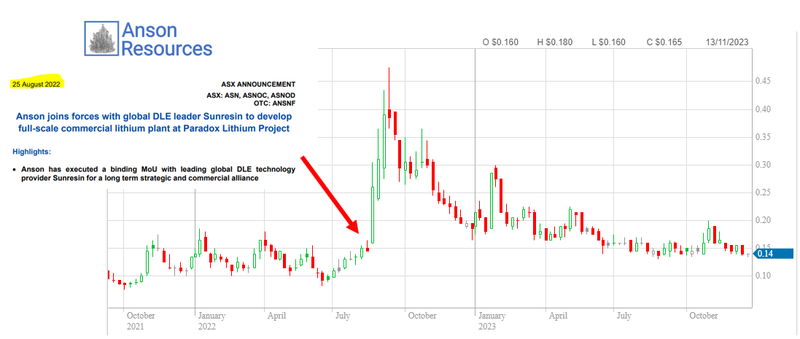
We think the market reaction is understandable, when it comes to brines in areas where it isn't hot for most of the year, DLE is make or break.
(if the weather is hot, lithium can be extracted from brines using evaporation ponds)
So rightly so the market waits to see a brine player make progress on the DLE front before buying into a company.
It's almost like a de-risking of the project from a technical perspective - showing the market the way forward to getting the brines out of the ground and processed into battery grade lithium carbonates.
Noting that MAN’s positive lithium concentrations were only seen across two of the six wells MAN sampled, the company now needs to replicate these peak results across its large landholdings in the Paradox Basin.
Repeating this success would give us confidence that one day MAN might catch up to Anson on both a resource basis and a technology basis.
Technology could then unlock the potential of the MAN’s project.
The thing is, though, Anson Resources is struggling to get its project going - there have been some difficulties at their project, not least of which is getting its DLE partnership to work with a Chinese DLE technology company, Sunresin.
Here’s where it gets interesting...
In the wake of the Inflation Reduction Act - incentives are now clearer for potential battery materials providers, like MAN, who has recently signed a Strategic Alliance Agreement with a USA based DLE team.
This leaves MAN free to pursue other DLE tech providers, ideally ones that ensure MAN remains eligible for IRA money like the “advanced Australian based DLE firm”.
Who are MAN’s Bill Gates backed DLE team?
The Electroflow team are one of the few DLE technology firms backed by Bill Gates’ Breakthrough Energy Group.
The Breakthrough Energy Group was set up back in 2015 with the primary goal of “Developing and deploying the critical climate solutions our world needs to reach net-zero emissions by 2050”.
The group has to date invested over $2BN and has already had some big wins...
One of those was in the DLE space - its US$20M investment in Lilac Solutions.
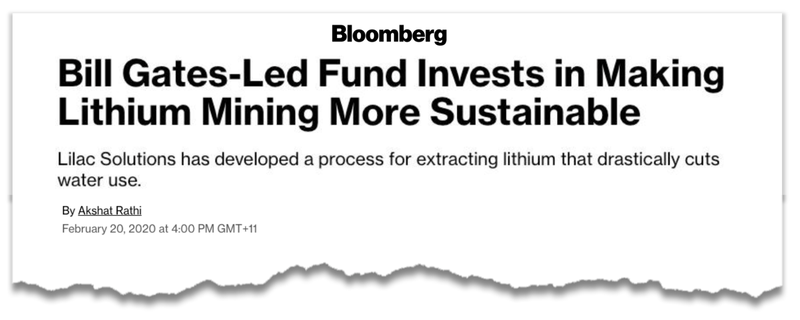
(Source)
Breakthrough was the group that incubated and funded the development of Lilac, which is now seen as one of the industry leaders in DLE technology.
Lilac’s tech is being used in some of the biggest brine projects in the world.
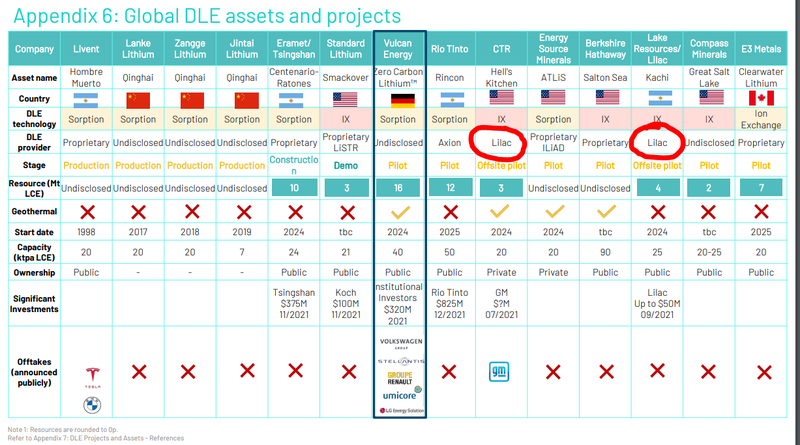
The relevance to MAN is that the DLE technology owned by Electroflow (MAN’s partner) was credible enough to get backing from a Gates backed company...
We see it as a huge tick of approval from a group of people who already understand the space extremely well.
MAN has ticked off two major potential catalysts, two more to go:
In previous notes, we mentioned that one of three potential catalysts that could trigger a re-rate in MAN’s share price higher was the DLE partnership.
For the full effect however, we think the company will need to get a maiden JORC resource though. Another run up in lithium prices would also be very helpful.
We’ve added a new potential catalyst as well, which is results from Electroflow’s ongoing test work.
Below are the key catalysts we think could be important movers for MAN:
- Direct Lithium Extraction (DLE) partnership ✅ - This was a major catalyst for Anson and was a key reason that led to its market cap reaching ~$490M in mid-2022. MAN announced its first partnership in December 2023. The market actually sold off MAN shares a bit following this DLE partnership announcement, but we think it's possible that any positive results from ongoing test work could be well received. Particularly if a breakthrough is made. (See catalyst #4).
- Sampling results ✅ - MAN has seen concentrations of ~340mg/L lithium in wells ~6km away from its ground. Anson’s resource has an average grade of ~127mg/L lithium. The two peak results came in at 147mg/L and 150mg/L, so a good start ahead of MAN releasing an exploration target.
- Maiden JORC resource 🔲 - A maiden JORC resource estimate will give the market something to compare MAN’s project size/scale potential to other US lithium brine peers. Anson has a resource of ~1mt lithium carbonate equivalent and is capped at ~$147M.
- NEW: Results from DLE testing of lithium rich brines 🔄- in yesterday’s announcement MAN said larger bulk samples have been sent to two Direct Lithium Extraction (DLE) providers, Electroflow and an “advanced Australian based DLE firm.” And furthermore, that results are due “shortly”, in Q1/Q2. So MAN may effectively have two bites at the cherry if one DLE provider can’t make it work.
MAN to get to maiden JORC in 1st half of 2024?
Most of the work MAN will be doing over the next 3-4 months will culminate in a maiden JORC resource estimate for its project.
Ultimately, we think the JORC will be what sets the stage for MAN’s project to be compared to its US lithium brine peers.
Right now, the market could be viewing MAN’s assets as conceptual given there are no resource estimates or exploration targets.
That’s why MAN is working toward a maiden JORC exploration target for its project.
The exploration target will set the scene for how big MAN’s project could be - then after the re-entry programs in Q1 2024, MAN can set about estimating its resource.
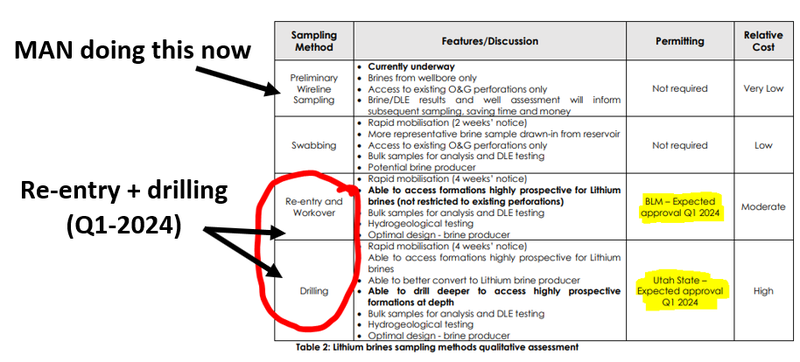
The results from the re-entry/drill program will be when MAN gets enough data to put out its maiden resource estimate.
All of this should happen inside the next 3-4 months.
Did someone say uranium? MAN has a large package of land in the right area...
Uranium is the hot topic in the market right now.
While MAN has been primarily focussed on lithium brines, in October of last year the company put out an announcement that said it would explore the uranium potential on its large package of land in Utah.
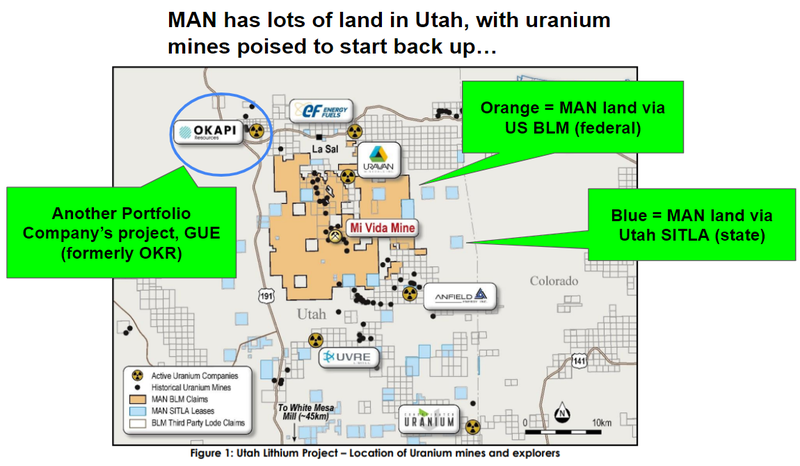
Over the course of 2023, the well-funded MAN was able to gobble up lots of land in the Lisbon Valley which historically produced 8% of the US’ uranium between 1949 and 2019, back when the US produced domestically.
It’s looking like MAN’s land grab was a shrewd piece of business.
MAN has a head start here too.
In the October 2023 announcement detailing the company’s uranium potential on the project, MAN said that the “historical well logs it has... include intersections of known uranium host rocks with, in most instances, gamma logs that potentially indicate the presence of uranium.”
Not only that, this well data can also be correlated with an existing 3D seismic it has at the project to identify potential uranium bearing sediments.
MAN said in yesterday’s announcement that in this quarter and the next, it intends to start field mapping and sampling for uranium as soon as possible depending on the weather.
It would be bitterly cold in that part of Utah this time of year, so hopefully MAN can buy some parkas, rug up and be in the field soon.
A side dish of bromine and potash
Also included in the results, was highly promising bromine and potassium results:
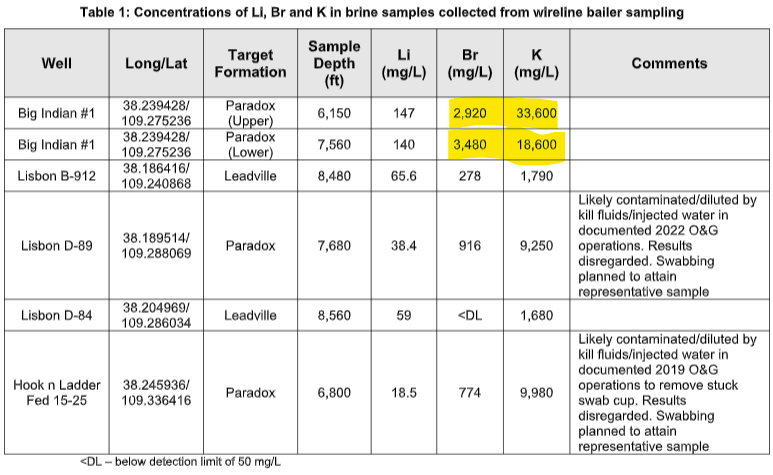
Bromine and potassium could be potentially highly valuable byproducts to the lithium production process each with their own use cases that have strong macro tailwinds.
Bromine is used in a wide range of applications - it’s worth noting that Bromine is a US$3.6 billion per year market with applications in flame retardants, water treatment, biocides and cutting-edge hydrogen–bromine batteries.
Hydrogen-bromine batteries are an emerging technology that requires no rare metals like lithium or cobalt.
They are particularly targeted at energy storage - so we’ll be paying close attention to MAN’s bromine results going forward.
On top of that the world’s largest lithium company, $21BN capped Albemarle derived 19% of its revenue in 2022 from bromine - so it's certainly a valuable resource.
As for potassium, it is used in Potash, a salt that contains potassium in water-soluble form which is a widely used form of fertiliser.
We’re very bullish on fertiliser as a whole - given its use in agriculture a growing global population.
Potassium results from MAN’s Utah Lithium Project have returned exceptionally high values of 40,656mg/L and 33,600mg/L for K2O and K respectively - the two forms of potassium found in potash-bearing brine deposits that are amenable to production.
MAN provided a table of major projects and we note that MAN’s potassium results appear to be broadly in line with these projects - noting that success will likely have to be replicated here .
We see these two results across bromine and potassium concentrations as potential added bonus for MAN as it pursues lithium DLE tech and a maiden resource.
What’s next for MAN?

Permitting of re-entry/drill program for Q1 2024 🔄
Before MAN can run its re-entry/drill program it will need to get its permitting sorted.
We are hoping this happens as soon as possible so that the work on ground can start early in Q1 next year.
JORC Lithium Exploration Target 🔄
MAN expects the exploration target to be ready inside the next few weeks.
The exploration target will be the first time we get to see the size/scale potential of MAN’s project compared to its peers.
Ultimately though, we want to see MAN convert the exploration target into a maiden resource.
DLE testing results 🔄
Yesterday’s announcement MAN said larger bulk samples have been sent to two Direct Lithium Extraction (DLE) providers, Electroflow and an “advanced Australian based DLE firm.” And furthermore, that results are due “shortly”, in Q1/Q2. So MAN may effectively have two bites at the cherry if one DLE provider can’t make it work.
Uranium fieldwork and sampling 🔄 - Markets are loving uranium at the moment, and MAN has an extensive land package in an old uranium producing district - MAN signalled its intention to test for U back in October 2023. This should start in Q1/Q2 of this year, depending on weather conditions.
What are the risks?
The two key risks we see for MAN in the short term are “Exploration risk” and “Processing risk”.
Exploration risk is relevant because there is always a chance the company finds uneconomic quantities of lithium in the wells it re-enters.
Processing risk is also a factor because, even if MAN does find a decent amount of lithium, there is no guarantee that any of that lithium can be extracted and processed at rates that make MAN’s project commercially viable.
Technology risk is also now a factor - large scale DLE technology has yet to be proven commercially viable and there is a chance that MAN’s new technology partners are unable to make the process work with MAN’s brines.
To see all of the key risks to our MAN Investment Thesis, check out our MAN Investment Memo.
Our MAN Investment Memo
In our MAN Investment Memo, you can find:
- MAN’’s macro thematic
- Why we Invested in MAN
- Our MAN “Big Bet” - what we think the upside Investment case for MAN is
- The key objectives we want to see MAN achieve
- The key risks to our Investment thesis
- Our Investment Plan
General Information Only
S3 Consortium Pty Ltd (S3, ‘we’, ‘us’, ‘our’) (CAR No. 433913) is a corporate authorised representative of LeMessurier Securities Pty Ltd (AFSL No. 296877). The information contained in this article is general information and is for informational purposes only. Any advice is general advice only. Any advice contained in this article does not constitute personal advice and S3 has not taken into consideration your personal objectives, financial situation or needs. Please seek your own independent professional advice before making any financial investment decision. Those persons acting upon information contained in this article do so entirely at their own risk.
Conflicts of Interest Notice
S3 and its associated entities may hold investments in companies featured in its articles, including through being paid in the securities of the companies we provide commentary on. We disclose the securities held in relation to a particular company that we provide commentary on. Refer to our Disclosure Policy for information on our self-imposed trading blackouts, hold conditions and de-risking (sell conditions) which seek to mitigate against any potential conflicts of interest.
Publication Notice and Disclaimer
The information contained in this article is current as at the publication date. At the time of publishing, the information contained in this article is based on sources which are available in the public domain that we consider to be reliable, and our own analysis of those sources. The views of the author may not reflect the views of the AFSL holder. Any decision by you to purchase securities in the companies featured in this article should be done so after you have sought your own independent professional advice regarding this information and made your own inquiries as to the validity of any information in this article.
Any forward-looking statements contained in this article are not guarantees or predictions of future performance, and involve known and unknown risks, uncertainties and other factors, many of which are beyond our control, and which may cause actual results or performance of companies featured to differ materially from those expressed in the statements contained in this article. S3 cannot and does not give any assurance that the results or performance expressed or implied by any forward-looking statements contained in this article will actually occur and readers are cautioned not to put undue reliance on forward-looking statements.
This article may include references to our past investing performance. Past performance is not a reliable indicator of our future investing performance.

